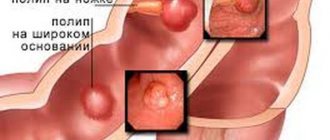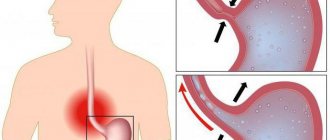Subtypes of stage 4 cancer and main symptoms
Liver cancer, in particular stage 4, is divided into two subtypes:
- 4A – both lobes of the liver are affected, and metastases have spread to nearby organs, the peritoneum, and nearby lymph nodes;
- 4B – metastases have already spread to distant organs.
In the later stages, the tumor destroys the organ, liver failure (liver failure) appears, and the organ literally crumbles. The following symptoms also develop:
- weakness throughout the body, fatigue;
- vomiting, nausea, heartburn, flatulence;
- heaviness in the stomach;
- weight loss;
- alternating insomnia and drowsiness;
- anemia.
Jaundice appears due to increased pressure on the bile ducts. Bile pigment accumulates in brain tissue. Concomitant diseases develop, such as ascites - accumulation of fluid in the abdominal cavity, which is accompanied by shortness of breath, tachycardia, and bleeding. The rapid development of the disease leads to loss of ability to work. It is difficult for a person to adhere to the usual rhythm of life. The patient lies down for a long time, and this condition leads to apathy and depression.
Features of the flow and classification
In 90% of cases, liver cancer occurs against the background of cirrhosis. Predisposing factors include alcoholism, prolonged inflammation (infectious, autoimmune, toxic hepatitis) and steatosis.
It is not always possible to overcome cancer, but it is quite possible to prolong a patient’s life and improve its quality. To do this, you need to accurately diagnose and begin treatment.
Treatment regimens correspond to the stage of the malignant process. The TNM classification is often used, which includes characteristics of the main tumor, involvement of regional lymph nodes, and the presence of distant metastases. Typically, clinical signs of the disease appear in the second stage, but the patient most often ignores them.
What is stage 4 cancer?
The fourth stage of cancer is an irreversible, uncontrolled process of growth and spread of tumor cells throughout the body, during which damage to neighboring healthy organs and tissues occurs, and the formation of distant (metastatic) tumor foci in distant organs. In stage IV cancer, the primary lesion can be of any size: from 5-6 mm in the case of a neuroendocrine tumor of the gastrointestinal tract or melanoma and up to 10-30 cm in diameter in the case of Ewing's tumor.
Criteria for diagnosing stage 4 cancer include:
- advanced cancer that has spread to the bones, lungs, liver, pancreas and/or brain, or
- fast-growing cancers (fast-growing tumor), or
- any type of bone cancer, or
- extremely fatal cancers (eg lung cancer, pancreatic cancer, multiple myeloma, squamous cell carcinoma, melanoma, etc.)
How is the stage of cancer determined?
The following studies help in diagnosing liver cancer and establishing its stage:
- Ultrasound of the abdominal organs - usually the examination begins with this as the fastest, most accessible and inexpensive method.
- Computed tomography and MRI help to obtain more accurate information, assess the size, number and location of lesions in the liver and other organs.
- X-ray of bones, chest (to detect metastases in the lungs).
- PET scanning is the modern “gold standard” for diagnosing late-stage malignant tumors. This method helps to identify small metastases in different parts of the body. During the study, a radiopharmaceutical is injected into the patient’s body: it accumulates in tumor cells and plays the role of a tag. Then pictures are taken using a special device, and all the places where the radiopharmaceutical is accumulated become visible - where the tumor foci are located.
- A biopsy helps detect tumor cells in the node and establish an accurate diagnosis. Typically, tissue for examination is obtained using a special needle, which is inserted under ultrasound or CT guidance.
- Diagnostic laparoscopy is an examination of the abdominal organs using a thin instrument with a light source and a video camera at the end, inserted through a puncture in the abdominal wall. Sometimes laparoscopy is performed to determine the stage of liver cancer.
The stage of cancer shows how much the malignant tumor has grown into neighboring tissues, whether it has managed to metastasize to the lymph nodes and to various parts of the body. This is very important information, because it helps the doctor develop optimal treatment tactics and build a reliable prognosis.
To determine the stage of cancer, doctors rely on the generally accepted TNM classification. The letter T denotes the size and location of the primary tumor, N - metastases in nearby lymph nodes, M - distant metastases. A numerical index is indicated next to each letter.
Combinations of different values of T, N and M are combined into four stages (there is also an additional one - zero):
- Stage 0. The tumor is contained within the tissues from which it developed and has not invaded adjacent structures. The tumor can be completely removed surgically;
- Stage I. The tumor is relatively small and has not had time to grow deeply into the surrounding tissue;
- Stage II. The tumor still does not spread to neighboring tissues, but is larger in size. Single metastases may be detected in nearby lymph nodes;
- Stage III. Cancer cells have spread to surrounding tissues and nearby lymph nodes;
- Stage IV. Metastatic cancer: Tumor cells have spread to different parts of the body.
Sometimes Latin letters are added to the numbers - A, B, C, if a substage needs to be distinguished in a stage.
Characteristics of the disease
A malignant liver tumor can develop from different parts of the liver. Therefore, there are several types of cancer, depending on what tissue it comes from. Each variety differs in the degree of aggressiveness and speed of development.
Primary and secondary cancer
Primary liver cancer ranks eighth in incidence among all malignant tumors. For example, in Asian countries this is the most common cancer pathology in men. Factors contributing to its development are considered:
- hepatitis B virus infection;
- alcoholism;
- intoxication with aflatoxin, a waste product of mold fungi;
- smoking;
- infestation with opisthorchiasis.
Secondary cancer is metastatic, that is, the main focus is in another organ. This is the basis for the classification of malignant liver tumors.
- hepatocellular carcinoma;
- cholangiocellular cancer;
- hepatocholangioma;
- angiosarcoma;
- teratoblastoma.
It is important to know! A cancerous tumor can grow in the form of nodes, spread to the entire liver tissue, or develop as cirrhosis. Secondary liver cancer occurs 20 times more often than primary liver cancer.
Metastases
One of the signs of malignant tumors is their ability to metastasize. These are cancer cells or pieces of pathologically altered tissue that enter other organs through the blood or lymph. Metastasis is a sign of advanced stage cancer. The spread of a malignant neoplasm is one of the causes of death.
Survival Prognosis
The earlier the disease is detected, the better the prognosis. However, the peculiarity of liver cancer is that at first it is asymptomatic, and then begins to develop at lightning speed. Therefore, the maximum lifespan for this tumor does not exceed five years, even with treatment. Most patients die in the first 2-3 years after diagnosis.
Treatment
To date, there is no method or panacea for stage 4 liver cancer. However, the most modern methods can slow down the development of the tumor and significantly alleviate the patient’s condition. Among the advanced therapeutic technologies are the following:
- Chemotherapy – with the help of the drugs “Nexavar” and “Sorafenib”, chemically active substances are introduced into the patient’s body, which has a detrimental effect on tumor cells.
Important! The use of drugs to treat other types of oncology to combat liver cancer has no effectiveness. - Radiation therapy – is performed using X-rays, which reduce the intensity of pain experienced by the patient, reduce the size of the tumor, which increases life expectancy.
- Vascular embolization – reducing the access of blood to them helps stop the growth of cancer cells. This is achieved by blocking the liver vessels with special substances. It is used for neoplasms with a tumor diameter of up to 5 cm.
- Ambilation is the introduction of ethyl alcohol into the area of a cancerous tumor. This substance destroys the tumor if its size is up to 3 cm.
For the effectiveness of treatment to be truly high, the patient must undergo therapy in a combination of several techniques.
Folk remedies
Today, many alternative medicine recipes have received proof of their effectiveness. The most popular are:
- Chaga infusion. Crushed birch chaga in the amount of 100 g is poured with cold boiled water. Infuse for 2 days and strain thoroughly. The course of treatment is a month with taking a glass of the drug three times a day 30 minutes before meals.
- Celandine. The root of the plant is crushed and the juice is filtered from it. Fill a liter jar halfway with the prepared preparation and add 0.5 liters of vodka. Stored for 20 days in a cool, dark place to acquire the desired pharmacological properties. The course of treatment is 2 weeks, requires taking 1 tsp half an hour before meals 4 times a day. tinctures.
- Hemlock tincture.
Pour the collected hemlock shoots into a liter jar, filling it about a third. Pour 0.5 liters of vodka into the plants and stir. After a few minutes, fill the jar completely with vodka and place the mixture in a dark, cool place for 2 weeks. The course of treatment consists of taking from 1 to 40 drops of tincture per day. The treatment regimen is a daily increase of 1 drop up to 40 and in the next 40 days a decrease of 1 drop. Thus, the duration of therapy is 79 days. After the course there is a 2-week break. Many patients leave positive reviews about the healing effects of just 3-5 courses (for the initial stages of cancer). - Oat decoction. Prepared from 2 liters of cold water and 1.5 cups of oats. The mixture is boiled for a third of an hour and left for up to a day in a cool, dark place. This is the daily dose of decoction, designed for 3 doses. Should be consumed one hour before meals. Prepare a fresh drink every day.
- Propolis. Over a period of 2 to 3 months, you should take 5 g of fresh product three times a day. To increase the effectiveness of the drug, you should refuse to eat an hour before consuming propolis. Used in cases of small tumors.
The main course of treatment for stage 4 liver cancer cannot be replaced by alternative means. But the use of folk wisdom as a prevention of relapse or additional methods of primary therapy will do an excellent job of alleviating the condition of patients.
Surgery is possible only if one or two metastases are found in the liver and they are located away from the vessels. Then you can perform liver resection and chemotherapy. In the rest, only chemotherapy or radiation therapy is possible. Drug administration during chemotherapy is often done locally to avoid overall toxic effects.
The drug is injected through a catheter into the portal vein and delivered to the metastasis through the blood vessels. Under the influence of the substance, necrosis of the tumor occurs and it is destroyed. Radiation therapy is also carried out.
Getting rid of liver oncology at the last stage of the disease is impossible. The main efforts of doctors are aimed at reducing pain and alleviating the patient’s condition. However, there are several effective methods of therapy that can maximally prolong the patient’s life.
Radioembolization of metastases
The procedure involves intravascular selective cauterization and the introduction of embolic particles with a radioactive isotope.
Chemoembolization
It is carried out to stop blood flow in the tumor. The procedure also involves delivering a chemotherapy drug to target the cancer locally. Chemoembolization has no side effects. There are usually no complications after surgery.
Ablation of cancerous lesions with radio frequencies
There are several indications for the procedure, the main one being the presence of tumors visualized by USCT and X-ray CT. In this case, it is necessary to have safe access to neoplasms. The size of the nodes (no more than 4 centimeters in diameter), the number of cancer foci (up to 5), and the absence of extrahepatic manifestations are also taken into account.
The procedure is performed by inserting a probe into the tumor and using alternating current. Due to the occurrence of ionic vibrations and the production of heat, cancer cells are destroyed. Contraindications to surgery are the presence of a tumor in the area of the intestinal loop, stomach, gallbladder, and degree C liver cirrhosis.
Folk remedies
Traditional methods of treatment can be used in combination with traditional medicine. But you should not consider them as an independent method of getting rid of the disease! This type of therapy is carried out only after the doctor’s permission!
Herbal treatment is very popular. It can improve the patient’s well-being and stop the spread of metastases. To combat cancer, celandine, bitter almonds, and plants of the poppy family are usually used. They contain a large amount of alkaloids. The principle of the effect of these substances on the body is similar to chemotherapy. In addition, celandine has immunomodulatory properties and enhances the body's protective functions.
An equally well-known folk method of treating the disease is to eat regular table soda. In this case, you should start with 1/5 of a teaspoon, gradually increasing the dose of the product to 1/2 of a spoon. Sodium bicarbonate is believed to neutralize the acidic environment in the body, which contributes to the development of cancerous tumors. This method of therapy has no scientific evidence, but many are convinced of its effectiveness.
Cancer cells tend to move from already affected organs to healthy ones through the lymphatic or circulatory system. Because of this, metastases may appear in the liver, as the main organ of detoxification, which has an intensive circulatory system, in cancer of the breast, stomach, lungs, esophagus or colon. But liver cancer itself, of course, also provokes malignant neoplasms in the immediate vicinity of the initial tumor.
How are metastases detected?
Sometimes even large metastases in the liver, the prognosis of which is very unfavorable, may not significantly disrupt the functioning of the organ for some time and may not manifest itself, for example, as jaundice. In these cases, bile enters healthy ducts, from where it is excreted. But an attentive physician will discover that the level of bilirubin in the blood has doubled.
Symptoms of liver metastases, treatment prognosis
The destruction of tissue by cancer cells takes a long time, which explains the absence of pronounced symptoms. In addition, the liver has high restorative properties. But over time, changes still make themselves felt. They appear:
- rapid weight loss for patients;
- his febrile state;
- an increase in the size of the affected organ;
- jaundice;
- skin itching;
- intestinal dysfunction;
- chest pain;
- anorexia.
Liver metastases can be removed surgically or using radiofrequency ablation - this will greatly facilitate and improve the patient’s life. True, this method is used only for small or single metastases. Performing economical liver resections in these cases can greatly reduce the risk of complications. The best results are obtained by patients who have one isolated metastasis in this organ due to colon cancer.
But the use of chemotherapy, especially with multiple metastases, unfortunately, is not able to heal the patient; it only stops the growth of tumors for some time. Radiation therapy reduces pain. But the hyperthermia method has recently begun to be introduced into clinical practice.
Metastases in the liver. Life expectancy forecast
Unfortunately, even with the most positive outcome of surgery and various therapies, medical practice shows that the stage of the disease, in which there are multiple metastases in the liver, shortens the patient’s life by up to a year. Often the time is reduced to six months. This happens because the patient simply does not have the organ volume necessary for life.
Causes of death
A person dies not only because a tumor grows in his body. By itself, it does not have a significant negative impact. The causes of death from liver cancer are usually complications of the malignant process:
- decay and suppuration of the tumor, leading to the development of sepsis;
- hepatic encephalopathy ending in coma;
- intestinal obstruction due to compression by a tumor;
- massive gastric or esophageal bleeding;
- secondary infections against the background of reduced immunity;
- congestive pneumonia;
- blood clotting disorder.
Painkillers for stage 4 liver cancer
The last stage of cancer is accompanied by the appearance of painful sensations. Depending on their intensity, specialists select the necessary anesthetics for the patient. They can be in the form of tablets, injections, or epidural anesthesia.
The following can alleviate the suffering of a seriously ill patient:
- “Motrin” – the active substance of the drug is ibuprofen. It is important to follow your doctor's strict instructions and not exceed the maximum dosage. Otherwise, side effects may occur. Information about them is contained in the instructions for the medication.
- Tylenol is a product made from paracetamol. Used for pain of mild to moderate intensity. In some cases, it can cause side effects: allergic reactions, abdominal pain, nausea.
If weak drugs do not bring the desired effect, a decision is made to use powerful opiates. You should be careful with such products and use them only in case of emergency and strictly as prescribed by your doctor! They have a strong narcotic effect and cause mental and physical dependence.
All these drugs are sold only with a prescription from a doctor!
Last days
Usually, if the patient wishes, the patient’s relatives can take him home, and he is prescribed and given strong drugs and painkillers that help reduce pain.
At this moment, you need to understand that the patient has very little time left and you need to try to reduce his suffering. At the very end, additional symptoms may appear: vomiting blood, intestinal obstruction, severe pain in the abdomen and chest, coughing up blood and shortness of breath.
At the very end, when almost every organ is affected by cancer metastases, it is better to leave the patient alone and let him sleep. The most important thing is that at this moment there are relatives, loved ones, close people next to the patients, who will reduce pain and suffering by their presence.
Prognosis: how long to live at this level?
Predicting life expectancy for a given patient with stage 4 liver cancer is not always easy. Life expectancy is influenced by many factors:
- age - in old people, blood clotting, immune functions of the body and cell regeneration and other features are much weaker than in young patients;
- a history of other diseases - many diseases accelerate the course of cancer, aggravating the general condition of the patient;
- type and nature of treatment measures - without the use of any means and methods of therapy, patients live no more than 1-1.5 years;
- lifestyle – introducing a diet, giving up bad habits and alcohol and other factors increase the patient’s life expectancy.
In general, active therapy can prolong the life of a patient with stage 4 liver cancer by up to 5 years.
Liver cancer at stage 4 is considered an incurable disease, which is characterized by the difficulty of achieving a long period of remission. If you follow the doctor’s instructions and follow the treatment regimen he has developed, you can significantly prolong your life. In practice, such patients can often live up to 5 years.
The prognosis is influenced by the individual characteristics and lifestyle of the patient. The presence of metastases and the rate of their progression play an important role in the formation of secondary neoplasms in neighboring organs. In addition to the liver, the tumor can grow into:
- rectum;
- stomach;
- prostate;
- gallbladder;
- ovaries;
- lungs;
- kidneys
With rapid tumor spread in patients with stage 4 liver cancer, even treatment cannot delay death. The maximum for these patients is only 1-2 years. Due to the ability of the disease to develop from the initial to the final stages in a matter of months, oncologists predict only 6% of patients will live for another 5 years.
Stage 4 liver cancer is a very dangerous and incurable disease. Treatment using various methods, including folk remedies, will not get rid of the disease, but can significantly improve the patient’s condition. Proper care will help make the last days or months of your loved ones' lives more comfortable.
Is it possible to cure
With such a serious illness and only chemotherapy, only one in six patients can survive a year. Having learned what liver cancer is, many are interested in how long they can live with the disease and such a diagnosis. An increase in life expectancy to five years is even less likely.
A definitive cure is believed to be virtually impossible. Although, medicine knows cases when, despite everything, the development of the disease stopped, the patient lived for more than five years.
Despite the serious condition of the patient, it makes sense to continue treatment of liver cancer at stage 4. The patient’s attitude comes first, because illness is not a death sentence. Therefore, people who have a positive attitude and follow all medical recommendations have the greatest chance of healing.
List of recommended treatment measures:
- analgesics – to relieve the patient’s suffering,
- plasma injection,
- antiemetics,
- surgical removal of the main tumor - if possible, if the body is not too weakened,
- Using chemotherapy, metastasizing lesions are destroyed.
Surgery may also be performed on the intestinal cavity to remove intestinal obstructions, which are sometimes caused by metastases. In any case, it is important to know how to treat stage 4 liver cancer, despite the fact that the prognosis for stage 4 liver cancer is bleak.
Stage 4 cancer: how do they die? Signs of approaching death and support for the patient
The approach of death in cancer patients is often preceded by the following changes:
- Reducing your daily diet
As cancer cachexia and general muscle weakness develop, a person's need for food and fluids decreases. Refusal to eat is a signal of the onset of the terminal stage of the disease. The patient's progressive general malaise requires the involvement of caregivers to provide daily care to the cancer patient.
- Violation of the frequency and depth of breathing
The preagonal stage of death is usually characterized by a decrease in the frequency and amplitude of breathing, which is associated with inhibition of metabolic processes and a reduction in the body's need for oxygen. The occurrence of noise during inhalation and exhalation indicates the presence of fluid due to cancer in the lungs. In such cases, the patient may find some relief by turning the body over to one side. Stage 4 cancer, as a person dies, is evidenced by the periodicity of respiratory activity with intervals of apnea.
Modern patients are increasingly choosing the video consultation format to receive recommendations from the most famous doctors, regardless of geolocation.
Find out how much it costs to communicate remotely with doctors who treat politicians and presidents!
To alleviate suffering, doctors may suggest using an oxygen cushion, through which oxygen enters the lung tissue. The function of people who look after a cancer patient during this period is to periodically wet the patient’s lips and mouth with water. When death occurs, drops of cold sweat appear on the pale skin.
- Psychological readiness for death
Cancer patients at the 4th stage of cancer are aware of the approach of imminent death and, as a rule, are psychologically prepared for death. The closer to the agonal stage, the more time patients spend sleeping. Also, in this category of people there is detachment and apathy.
In patients with a labile psyche, psychosis and unconsciousness may occur, which can last for quite a long time.
Important to know: The death of a cancer patient: what is it like?
Oncologists recommend involving psychologists to care for such patients.
Close people should create all the conditions for the dying person for their last days of life: you can turn on calm, relaxing music, read books, talk about the years passed together.
People surrounding a patient at the last stage of cancer always ask the question: “Stage 4 cancer: how do they die?” In this situation, psychologists have one answer: leaving life is very individual for each individual person. But one thing needs to be remembered: this time should be spent in such a way as to allow the patient to pass away peacefully.
As cancer cachexia and general muscle weakness develop, a person's need for food and fluids decreases. Refusal to eat is a signal of the onset of the terminal stage of the disease. The patient's progressive general malaise requires the involvement of caregivers to provide daily care to the cancer patient.
The preagonal stage of death is usually characterized by a decrease in the frequency and amplitude of breathing, which is associated with inhibition of metabolic processes and a reduction in the body's need for oxygen. The occurrence of noise during inhalation and exhalation indicates the presence of fluid due to cancer in the lungs. In such cases, the patient may find some relief by turning the body over to one side. Stage 4 cancer, as a person dies, is evidenced by the periodicity of respiratory activity with intervals of apnea.
To alleviate suffering, doctors may suggest using an oxygen cushion, through which oxygen enters the lung tissue. The function of people who look after a cancer patient during this period is to periodically wet the patient’s lips and mouth with water. When death occurs, drops of cold sweat appear on the pale skin.
Cancer patients at the 4th stage of cancer are aware of the approach of imminent death and, as a rule, are psychologically prepared for death. The closer to the agonal stage, the more time patients spend sleeping. Also, in this category of people there is detachment and apathy.
In patients with a labile psyche, psychosis and unconsciousness may occur, which can last for quite a long time.
Important to know: The death of a cancer patient: what is it like?
Oncologists recommend involving psychologists to care for such patients.
Close people should create all the conditions for the dying person for their last days of life: you can turn on calm, relaxing music, read books, talk about the years passed together.
People surrounding a patient at the last stage of cancer always ask the question: “Stage 4 cancer: how do they die?” In this situation, psychologists have one answer: leaving life is very individual for each individual person. But one thing needs to be remembered: this time should be spent in such a way as to allow the patient to pass away peacefully.











